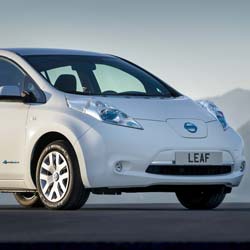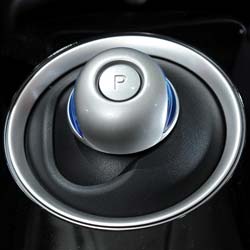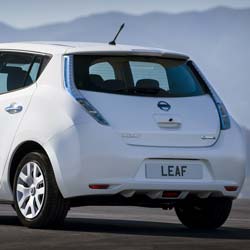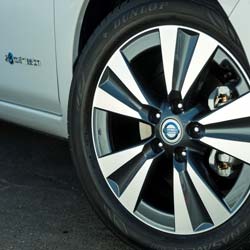12 Months in the Nissan Leaf Tekna
[/vc_column][vc_column width=”2/3″]It begins to look as if my wife might not fully have come to terms with the all-electric Nissan Leaf we have been keeping at home on a year’s loan.
Last Sunday morning, she was setting off in the Leaf to take our children and our dog for a long walk round a loch (we live in Scotland), walking to a lovely café for lunch and then trudging back to the parked Leaf. The march would take a total of about four hours. More significantly, the round trip for the car journey would be about 40 miles.
The theoretical range of the Leaf, fully-charged, is up to 90 miles. That number varies extremely depending on the ambient temperature, the topography of the route, the number and weight of the people in the car and the number of electrical accessories (such as audio and air-conditioning) that are also draining the battery. I just squeaked home last winter, with only three miles remaining on the range indicator, after a round trip of under 70 miles with a business partner through the Ochils. My family’s 40-mile Sunday jaunt would certainly, therefore, be comfortably within its range; but I imagined that my wife might get alarmed if she saw the available range indicator falling below, say, 20 miles – which could have happened.
“You ought to make sure,” I said, “that you use the regenerative braking to extend the range.”
She looked at me blankly.
I tried to explain that, if – while the car is in motion – you move the drive shift selector on the Leaf through a quadrant, first to the right and then down again (exactly the same movement as selecting D for Drive to go forward from rest), you then activate a more aggressive style of regenerative braking which helps to recharge the battery and extend the range. A letter “B” appears on the instrument display to confirm that you have selected this option.
It was obvious from her face that not one word I had spoken made the slightest sense to her. The very fact that the Leaf recharges itself at all when you lift off the accelerator pedal was evidently mystifying news to her.
Well, it’s early days: we’ve only had the Leaf on loan for 11 months. And a fully electric car does demand such a completely new set of attitudes and driving habits that you practically have to change your life for keeps to make the most of it.
It took me fully three months to realise that the most efficient use of the Leaf is as the primary family car – the one that does the school run and the after-school clubs, the supermarket trip and the health club. In other words, this is the car for daily use over average trips. If you’re going to visit your granny in another county, you probably ought to use a conventionally-fuelled car. If you want to travel from Scotland to England, you might be better off on a train. There are no charging points for electric cars in the Borders as yet and, in any case, a full recharge for the Leaf takes six hours.
Research has shown, however, that 10% of all car journeys are less than one mile and the great majority are less than seven miles. That would certainly be true of our usual car use.Research has shown, however, that 10% of all car journeys are less than one mile and the great majority are less than seven miles. That would certainly be true of our usual car use. My wife commutes a daily 40-mile round-trip to work and likes to take our MX-5 which suits her perfectly; but I, who work at home and am the parent who does most to look after the children during the week, rarely drive more than 15 miles a day. The Leaf is ideal for that kind of use.
After the Leaf arrived on loan, we took advantage of the government’s largesse to have a PodPoint installed at no cost on the wall beside our front door. This meant not only that we acquired a £1000 increment in the value of our house for nothing but also that we no longer had to run a cable through a window to a 13-amp socket in the living-room to charge the car.
Instead, we plug in the charging cable from the PodPoint when we’ve finished with the Leaf at the end of the day and leave it on charge overnight so that it’s fully ready to go every morning. If we were going to keep the Leaf forever, it would make most sense to set up solar panels on the roof so that we could charge the car during the day at no cost from the electricity the panels would generate. But, in order to effect that desirable change, we would have to install a water tank in the attic. And that would mean that my wife would have to shift the vast collection of ebay acquisitions she has stored up there in boxes. Which she is reluctant to contemplate. Don’t get me started.
[/vc_column][/vc_row][vc_row border=”none” bg_color=”rgba(255,255,255,0.27)” padding_top=”0px” padding_bottom=”20px” no_margin=”true”][vc_column width=”1/1″ fade=”true” fade_animation=”in-from-right” fade_animation_offset=”350px”]Charging the car from the house’s mains supply seems to be costing us an extra £20-odd on our electricity bill every month; but that goes against the £70-odd we used to spend every month to fuel a conventional family car.
The most serious cost in the Leaf would be its depreciation – more than 50% in the first year of ownership. Our top-spec Tekna version would have cost £31,600 (less £5000 government subsidy) a year ago. You could buy it for little more than £13000 today.
Despite all that, however, I am seriously thinking of keeping the Leaf. I love its build quality, which is as superb as a Jaguar’s.Fears over battery life that dogged electric cars a few years ago now seem to be abating; but, even so, if you reckoned that the battery might last nine years and kept this car for the whole of that period, it would – in all probability – be worth less than a glass of water at the end.
Despite all that, however, I am seriously thinking of keeping the Leaf. I love its build quality, which is as superb as a Jaguar’s. I love its delightful silence, its silken ride and its nimble handling. I love the fact that the charging bays in the best spots in the municipal car-park in our local town are always empty so that I can always count on a place there, even on a Saturday morning. I love the fact that, the last time I checked, only eight people in my county are driving an electric car and I am the only one with a Leaf.
Most of all, I love the idea that we still have so much to learn about this car. I’m in no position to jeer at my wife over the regenerative braking: I still haven’t figured out how to use the on-board information set-up that Nissan call CarWings which enables you remotely to access the car’s data online and even to switch on the heaters for the steering-wheel and the seats on a cold morning before you go out to the car.
That would be a boon but it’s beyond me.
Obviously, we need at least another year.
Share This
Drive.co.uk/AI – Your Personal Car Research Assistant
September 20, 2025The Suzuki ALLGRIP Anniversary
August 4, 2025All-New Nissan Leaf, the UK built Electric Car
June 17, 2025Reviewed: The Genesis Electrified GV70 (MY25)
June 9, 2025No items found, please search again.




